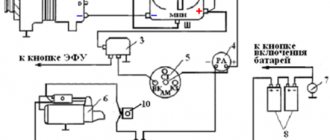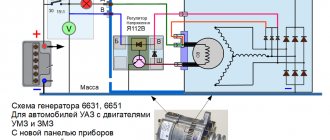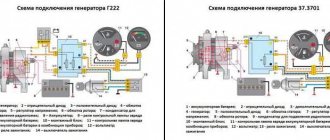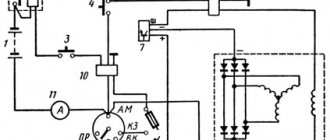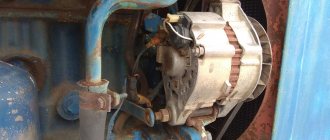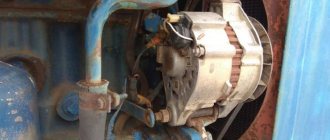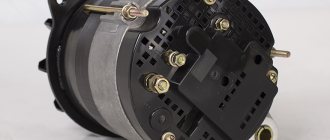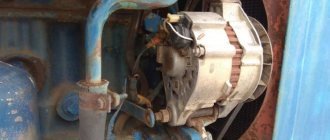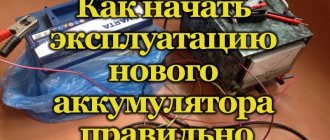01/26/2022 20,816 KAMAZ
Author: Ivan Baranov
To provide power to energy consumers, a generator is installed on the vehicle; KAMAZ can be equipped with a generator that meets the requirements. The article describes the device, provides technical characteristics, possible problems, as well as ways to eliminate them.
[Hide]
GENERATOR
Technical description
KamAZ vehicles are equipped with a three-phase synchronous alternating current generator G272 with independent electromagnetic excitation and a silicon rectifier unit built into the cover on the slip ring side.
The generator (Fig. 258) is mounted in the upper front part of the engine and is attached to the bracket with two legs, and with the third leg to the tension bar. The generator is driven by two V-belts. The gear ratio of the pulleys is 2.41.
Rice. 258. Generator: 1—pulley; 2—fan; 3—drive side cover; 4—stator; 5—rotor; b—rotor shaft; 7—rectifier block; 8—cover from the side of the slip rings; 9—contact ring; 10—bearing cover; 11—brush holder
Since 1980, KamAZ vehicles of all models have been equipped with a G273A generator set * (Fig. 259), consisting of a three-phase synchronous generator with direct-flow ventilation and a rectifier unit and an integral voltage regulator built into the generator.
( * Since July 1, 1985, the G273V generator has been installed, which has an additional plug output from the generator phase. Otherwise the design is identical to G273A.)
The small-sized voltage regulator YA120M built into the generator brush holder is an integrated circuit and cannot be repaired.
Basic malfunctions and their elimination
| Causes | Elimination methods |
| The crankshaft rotates at the rated speed, and the ammeter shows the discharge current | |
| Low drive belt tension | Pull the belt. |
| Contamination on slip rings | Clean with a paper towel soaked in gasoline. |
| Breakdown in the rectifier block | Replace block. |
| Brushes get stuck, brushes wear out | After removing the brushes, you need to check their size. If the height is less than 10 mm, the brushes should be replaced. Clean from dirt. |
| A short circuit has occurred in the stator windings | The stator is changing. |
| The excitation circuit is open | Ring the chain and repair the break. |
| Break or short circuit of the rotor windings | Replacing the rotor as a whole. |
| Voltage regulator does not work | Replace with a good one. |
| High charging current | |
| Short circuit in the circuit or in the brush assembly | Chain restoration. |
| The regulator does not function | Replace the regulator with a new device. |
| Load current fluctuates | |
| Brushes sticking, belt slipping | Adjust the belt, clean the brush holder, measure the height of the brushes. |
| Bearing overheats | |
| The belt is too tight | Adjust tension. |
| Increased noise during generator set operation | |
| Worn bearing | Replace the part. |
| The pulley is poorly secured | Tighten the fastening nut. |
| Fan bent | Replace with new one. |
Video “How to connect a Kamaz generator set”
This video demonstrates how to correctly connect a Kamaz generator (the author of the video is altevaa TV).
Constant undercharging of the battery or its absolute discharge at the most inopportune moment is a headache for many car owners. One source of these problems may be the generator. But how to check it? Perhaps it's not his fault at all? Let's figure out together how much the generator must produce for the normal functioning of all car systems and maintaining the battery in a charged state.
Design and features of KAMAZ generators
The generator consists of the following components and parts:
– The rotor is a coil (aka field winding) made of copper wire, enclosed between two steel pole pieces, and located on the shaft. The pole pieces are made in the form of “crowns” formed by six beak-shaped protrusions facing each other. The ends of the winding are connected to copper ring contacts located on the front or rear of the rotor shaft; – The stator is a ring core, in the grooves of which the turns of three coils (windings) are laid, in which current is generated. Since the generator is three-phase, there are three coils in the stator, and they are connected by a star; – Body – usually consists of two halves, which are held together with bolts or studs. In some generator models, the stator core is also part of the housing. At the ends of the housing halves there are holes for the passage of cooling air. Also, bearings are usually installed in the housing for free rotation of the rotor shaft; – Brush assembly - two graphite brushes and a brush holder (with springs to ensure constant pressing of the brushes to the contacts on the rotor shaft) to supply voltage to the rotor winding. Usually located on the back cover of the case; – Rectifier - a separate block of diodes (usually six of them are used - two for each stator winding), located on the rear cover of the case; – Voltage regulator - a unit made of discrete elements or microcircuits that ensures constant voltage in the on-board network at a level of 24 V. Usually installed on the back cover of the generator. On many generators, the seasonal voltage adjustment switch is also located here; – Cooling impeller - metal or plastic.
The generator housing has eyes (feet) for mounting this unit on the engine, as well as for adjusting the position of the generator and the tension of the drive belt. The generator is installed at the front end of the engine, in its upper part. Fastening to the block is carried out by two coaxial eyes (paws), another eye is bolted to the drive belt tension bar.
The generator must have several contacts for connection to the vehicle's electrical system. All generators have a “+” contact, which connects to the batteries, and a “-” contact, which goes to the vehicle ground. There may also be special contacts for outputting the phase to the voltage regulator, a contact for connecting to the toggle switch of the starter and instruments, and others. The “+” and “-” contacts are usually made in the form of bolts (since currents up to 90 A pass through them), and the remaining contacts are made in the form of a standard connector.
Connection Guide
To successfully connect the generator set, a wiring diagram is required.
Electrical connection diagram
In addition, for proper operation of the installation, you must strictly observe its connection according to the pin diagram:
- the battery and load are connected to the “+” terminal;
- the vehicle ground must be connected to the “-” terminal;
- terminal “B” or “W” is intended to connect to the instrument switch and starter.
- pin “W” or “~” is the phase pin to which the tachometer and the relay blocking the starter are connected;
- output “+D” or “D” from additional diodes for connecting a control light.
It is important to make the connection correctly, otherwise the vehicle components and the generator itself may fail.
Price issue
1. Bosch for KAMAZ (price - from 18,990 rubles)
2. G-288-O (price - from 3,795 rubles)
3. G-273 (price - from 2,000 rubles)
Loading...
What kind of charging should go to the battery from the generator?
It is traditionally believed that 13.5-14.5V should be supplied by the generator to the battery and this is absolutely enough to replenish the battery costs.
It is worth considering that using a battery with a higher power in a car than the manufacturer recommends also requires the installation of a more productive generating device.
It is necessary to take into account the load that the generator must withstand - it is calculated based on the maximum indicators of all electrical appliances and car systems.
Do not forget that the charging current from the energy-generating device will allow you to start the car in the cold season. In order to avoid problems with starting the car, we recommend purchasing generating equipment, the charge current of which will be approximately 10% of the capacity of the power source. That is, a battery of 100 A/h requires a generator that can produce 10A. Please note that for many cars, 100 amp equipment will operate at its maximum capacity, because the power consumption of the automotive system is in the region of 80 amps. Therefore, the choice of a source generating energy must take into account both the battery capacity and network consumption.
Types, models and characteristics of KAMAZ generators
KAMAZ vehicles use traditional synchronous three-phase alternating current generators with electromagnetic excitation (and self-excitation). The generators are driven by the diesel crankshaft. All generators produce a current voltage of 27-30 V (24 V is supplied to the network, part of the current is lost on the rectifier and regulator), which is regulated depending on the climatic conditions of the vehicle.
Currently, there is a fairly wide variety of KAMAZ generators, which differ in design, cooling method, drive type and applicability.
By design, there are two types of units:
– Generator - this category includes generators equipped only with a rectifier unit, and the regulator is designed as a separate unit; – Generator set - this category includes generators in which, in addition to the rectifier unit, a voltage regulator is also built-in.
Nowadays, generator sets are predominantly used, and simple generators were installed on early truck models. Although even now conventional generators are widely used, since there are still many old KAMAZ trucks in use, and their repair is easier.
Based on the type of drive, generators are divided into two groups:
– With V-belt drive - generators of this type are equipped with a double pulley for installing two V-belts (drive from the crankshaft pulley); – With serpentine belt drive - generators of this type have a pulley for a serpentine belt (usually 10-ribbed).
The classic V-belt drive is used on early and many current models of trucks with KAMAZ-740 engines. Poly V-belts are used on the most modern models of trucks with domestic and foreign engines (Cummins) of environmental classes above Euro-2.
All generators are air-cooled, but they are divided into two types depending on where the impeller is installed:
– External installation - the impeller is located on the shaft in front of the front cover of the generator housing; – Internal installation - the impeller is located on the shaft inside the generator, in front of the rotor or directly on the front pole piece of the rotor.
An external impeller is a traditional solution that is also used on many modern generators. However, today an internal impeller is increasingly used, which, while highly efficient, is safer; it is protected from external influences, so it cannot jam or break.
Currently, the market offers a large number of models of KAMAZ generators, but you should pay attention to several basic models and groups of generators. Since the 1970s (from the very beginning of the production of KAMAZ trucks), G-288 generators and G-273-A generator sets have been installed. Since 1985, modified G-288E generators began to be used, and from the 1990s to 2000s, dozens of different generator models began to be installed on KAMAZ trucks, including the improved G-273-B1 and many foreign-made units (including Bosch) .
Issues of maintenance and repair of KAMAZ generators
Truck generators require two types of maintenance:
– Seasonal maintenance when transferring a car to summer or winter operation; – Inspection and adjustment during routine maintenance or in the event of a malfunction.
During seasonal maintenance, the seasonal adjustment switch is moved to position “W” (“Winter”) or “L” (“Summer”). When the cold season sets in, when the temperature remains stably below 0°C, the switch is moved to position “Z” - in this case, the regulator produces a voltage of 28.8-30.2 V. Increasing the voltage in cold weather compensates for the voltage drop on semiconductor devices in frost, which guarantees normal voltage in the network. When the warm season begins, when the temperature has stably established above 0°C, the switch is moved to the “L” position - in this position the generator produces a voltage of 27-28 V.
If the generator drive belt is weakened (which is manifested by low voltage, slipping of the belt along the pulley), it is necessary to adjust its tension. To do this, loosen the bolt securing the generator to the tension bar, move the generator to ensure the desired degree of belt tension, and tighten the bolt again.
How many amperes does a car alternator produce per battery?
The current strength required by the electrical system of each car is individual and depends on the number of electricity consumers and their values. And also the charge current must be sufficient to charge the power source.
It is worth noting that ampere readings appear only when there is a load in the vehicle’s electrical system and, accordingly, the battery is discharged. After starting the car engine, the charging current is about 6-10 amperes and drops over time, because the battery is charging, taking on the main energy consumption. If you turn on additional equipment - headlights, radio or heated mirrors, you can see an increase in the charging current values.
When purchasing a generator, pay attention to its technical characteristics, which the manufacturer indicates on the case - that’s where you will find information about the maximum current that will flow to the battery.
In the table below you can see the approximate current values that the generator shows at different loads.
Table 1. How many amperes the generator produces under load.
